
A series of silver coins issued in Metapontion during the 5th century BCE (images 1-5) depict a statue of Apollo, which is believed to be the one that stood near a statue of Aristeas within a sanctuary to Apollo in the city’s central market area, according to Herodotos. Excavations in that area in the 1980s revealed two large stone platforms and a well, dated to the early 5th century, and a large number of bronze laurel leaves – a sure sign the area was used for the worship of Apollo – around one of the platforms. According to Herodotos’ story, partly confirmed by a second story told by Athenaios that mentioned a ‘bronze laurel’ at the site, the sanctuary was set up because Aristeas commanded it during a supernatural visit to the city centuries after his natural life.
The coins depict a naked, muscular Apollo carrying a bow in his left hand and holding a large, standing laurel branch with his right hand, while his head is turned and looking to his right. The depiction belongs to a type of Apollo representation known as Apollo Daphnephoros (‘laurel-carrier’), which came into use in the late 6th century BCE and was common in the 5th century BCE (Castoldi, Albero di Bronzo, 29-41). In one of the Metapontion coin dies (image 2), the laurel branch rests on a platform, making it clear that a statue was being depicted.
David Hernández Castro has identified a stone platform (images 9 and 10) present among the ruins at the Metapontion site which he proposed is the platform depicted on that coin die (image 2). The stone platform has a large vertical hole through it into which he proposed the laurel branch was fixed. He further proposed that the platform was originally an altar used for the worship of Herakles, as depicted on other Metapontine coins showing Herakles pouring libations onto a small altar (images 7 and 8), but was later repurposed as a repair measure to support the Apollo statue’s laurel branch (Hernández Castro, El Temenos). The visual match seems compelling, but some things need to be checked, particularly whether the dimensions of the platform match such use, whether any information exists about its find context, and whether there are any clues to its age. Antonio De Siena (Profilo Storico, 35) and Sydney Noe (Coinage of Metapontum, part 2, 8 and 62) identified the platform on the Apollo coin (image 2) as an altar.
Attilio Stazio (Monetazione di Metaponto, 83) and Joseph Coleman Carter (Countryside at Metaponto, 217) have suggested that the large laurel branch held by the Apollo statue was the ‘bronze laurel’ mentioned in the Athenaios story. Others have followed De Siena’s suggestion (Metaponto Scoperte) that the market sanctuary included both a statue holding a large laurel branch and a separate bronze laurel tree.
The coin issue’s apparent commemoration of the sanctuary, dated by De Siena to the early 5th century BCE, implies that the Apollo statue coins could have been introduced already in that same period. Numismatists have generally dated the coins to 470-430 BCE (Rutter, Greek Coinages, 49-51; Stazio, Monetazione di Metaponto, 83-86).
Although Roman-era literature associated reverence for Aristeas with Pythagoreanism, and Metapontion figured prominently in legends about the life of Pythagoras and early Pythagoreanism, it is unclear to what extent the Metapontine market sanctuary to Apollo was connected to Pythagoreanism. The matter is clouded by the lack of reliable sources on the early history of Metapontion: see the commentary on the site of the market sanctuary.
The large, standing laurel branch is the most unusual aspect of the Metapontion statue, as Apollo Daphnephoros normally holds aloft a much smaller branch (ibid.). Curiously, one other statue of Apollo is represented with an almost identical composition to the statue depicted on Metapontine coins: a colossal statue that stood in Apollonia Pontika (modern Sozopol, Bulgaria) by Kalamis, a well-known Athens-based sculptor of the 5th century BCE (Dörig, Kalamis; Strabo 7.6; Appian, Illyrian Wars, 5/30; Pliny, Natural History, 34.18/39). That statue is best represented on two unique coins of the 2nd century BCE (images 13 and 14); more common later coins show the same composition but more crudely (Lacroix, Statues sur les Monnaies, pl. XX, nos. 6-9). Judging from the coins, Kalamis’ colossal Apollos similarly carried a bow in his left hand, held a large standing laurel branch with his right hand, and had his head turned to face right. The only clear difference between the compositions of the Apollonia and Metapontion statues is the inclusion on the Apollonia statue of a bird – perhaps a raven – perched in the middle of the laurel branch. However, aside from their similar composition, which could have been coincidental, no evidence connects the Kalamis and Metapontion statues, nor is there any evidence connecting Kalamis or the Apollonia Pontika colossus to Aristeas or the Arimaspeia.
Phyillis Williams Lehmann proposed to identify a bronze statuette acquired by the British Museum from the antiquities market (image 11) as a copy in miniature of the Metapontine Apollo Daphnephoros statue. The statuette has a mostly similar composition, but its head faces forward (Lehmann, Statues on Coins, 33-35). Its origin was earlier located based on style as west Sicily and likely Selinous (Poulsen, Strenge Stil, 101-103). Lehmann also suggested a full-sized bronze statue at the British Museum from Zifteh, Egypt, was based on the Metapontine Apollo statue, but seeming similarities owed to a creative 19th century restoration of the Zifteh statue’s limbs (Oddy and McIntyre, Life-Size Bronze; McIntyre, Restoration and Repair; British Museum 1840,0401.1).
This use of coins to learn the appearance of the Metapontine Apollo sanctuary’s statue faces one complication: one Metapontine coin issue, of a smaller denomination, shows Apollo in a different pose, with his head turned facing left, and his right hand resting on his hip (image 6). Instead of holding a laurel branch, this coin has two curved laurel branches, together suggesting a wreath, shown floating independently to both sides of Apollo. Lehmann (op. cit., 35-39) proposed that this coin represented a second Apollo statue. Indeed there were presumably two major statues of Apollo in Metapontion: at the market sanctuary, and in a larger and older temple to Apollo Lykios (Mertens, L’Architettura). But we probably need to allow that the makers of coin dies sometimes creatively modified traditional compositions, and therefore also allow some possibility that the composition of the Apollo statue that we see on most Metapontine coins might not have been entirely faithful to the statue.
It has been suggested that a torso of a marble statue found on the territory of the larger Apollo temple (image 12) might have been the statue that stood in the market sanctuary, if for some reason it was later moved (De Siena, op. cit.; Mertens-Horn, Scultura di Marmo, 75). But it seems more likely the statue to which that torso belonged stood in or near the Apollo temple.
A well-known 5th century BCE south Italian painter of red-figured vases, known as the Pisticci painter but believed to have worked in Metapontion, painted a scene that includes an Apollo Daphnephoros statue (image 15, left side) with a somewhat similar composition to the one depicted on Metapontine coins. The Pisticci painter’s Apollo statue stands on a low platform, and similarly holds a long laurel branch and bow, but holds them in the opposite hands from the Apollo on Metapontine coins, and faces forward. The laurel branch of the Pisticci painter’s Apollo statue is held up in the air, not resting on the ground or on a platform, and it has relatively few branches and leaves at the top of a long, mostly bare branch. There are two large snakes wrapped around the statue, but they are thought to be part of the scene’s action, not part of the statue. The scene is thought to depict a scene from Sophokles’ lost tragedy Laokoon just after the god Apollo, who stands to the right, sent two snakes to kill the son of Laokoon, who has been unrealistically dismembered by the snakes, while Laokoon looks on distraught and his wife swings an axe at the snakes (Schmidt, Laokoon-Mythos).
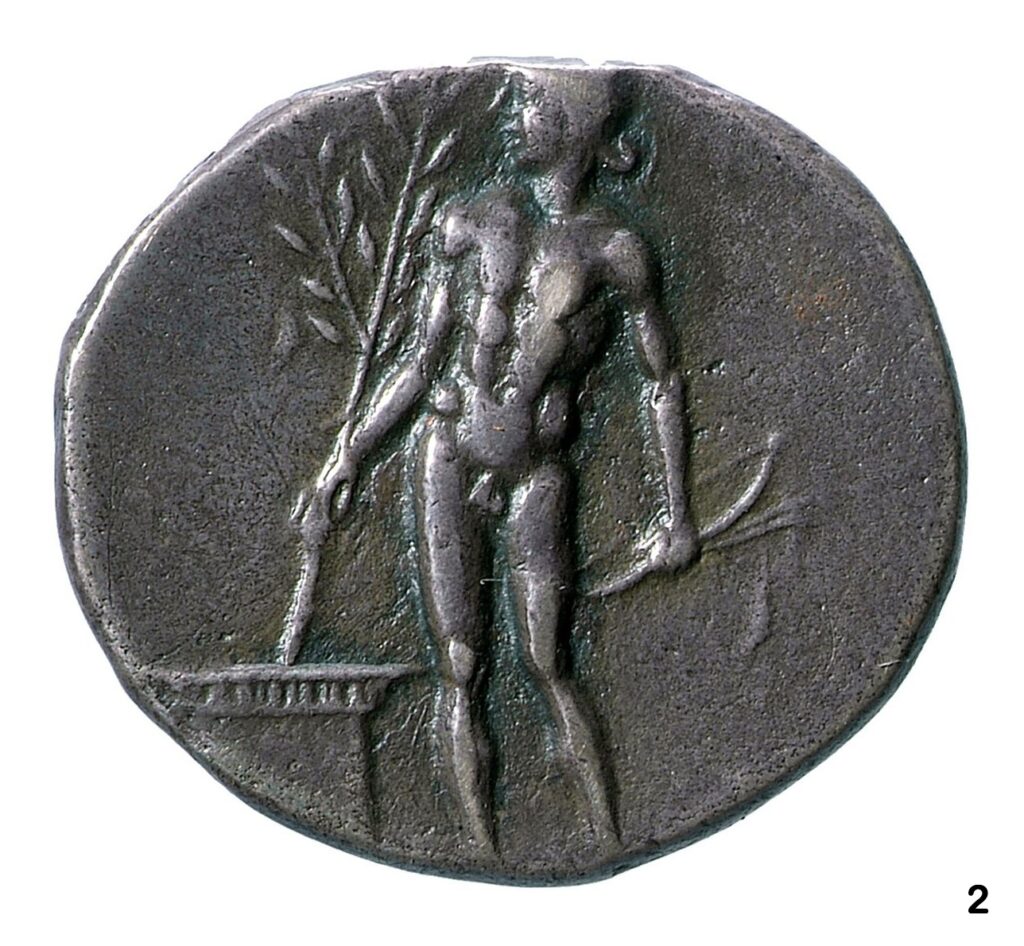



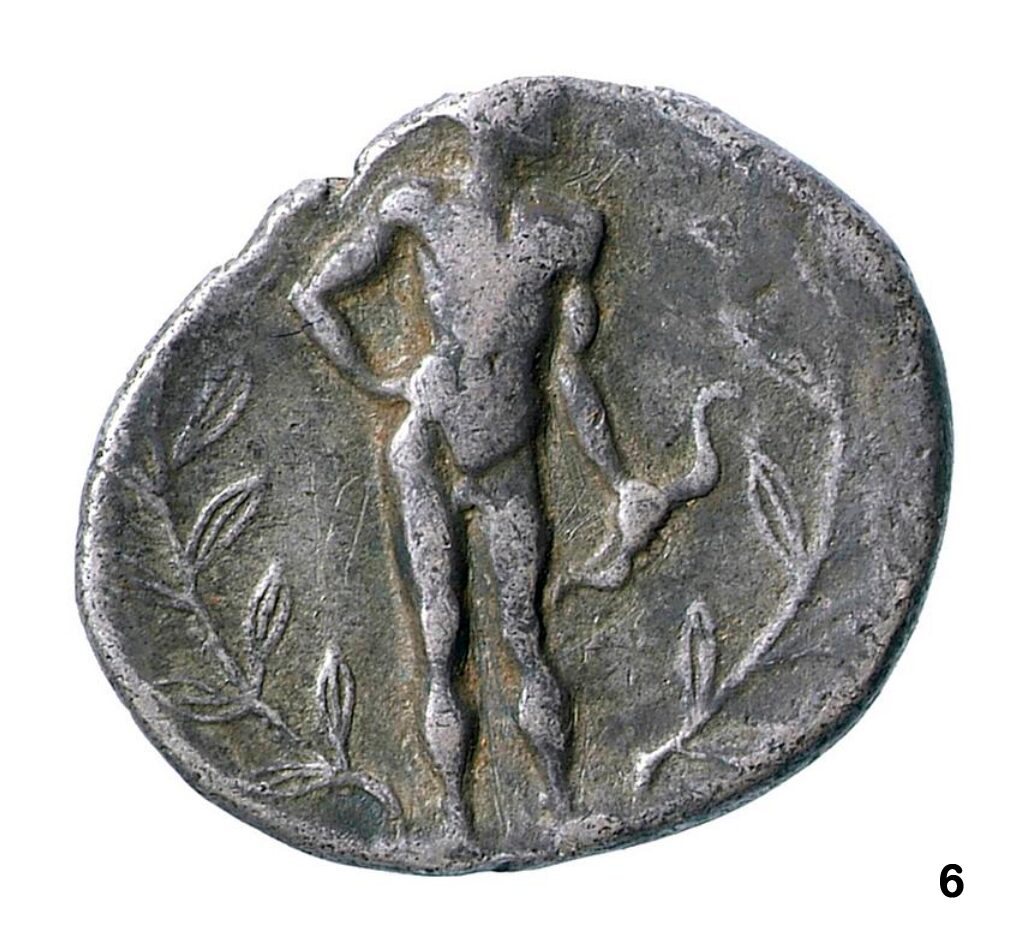
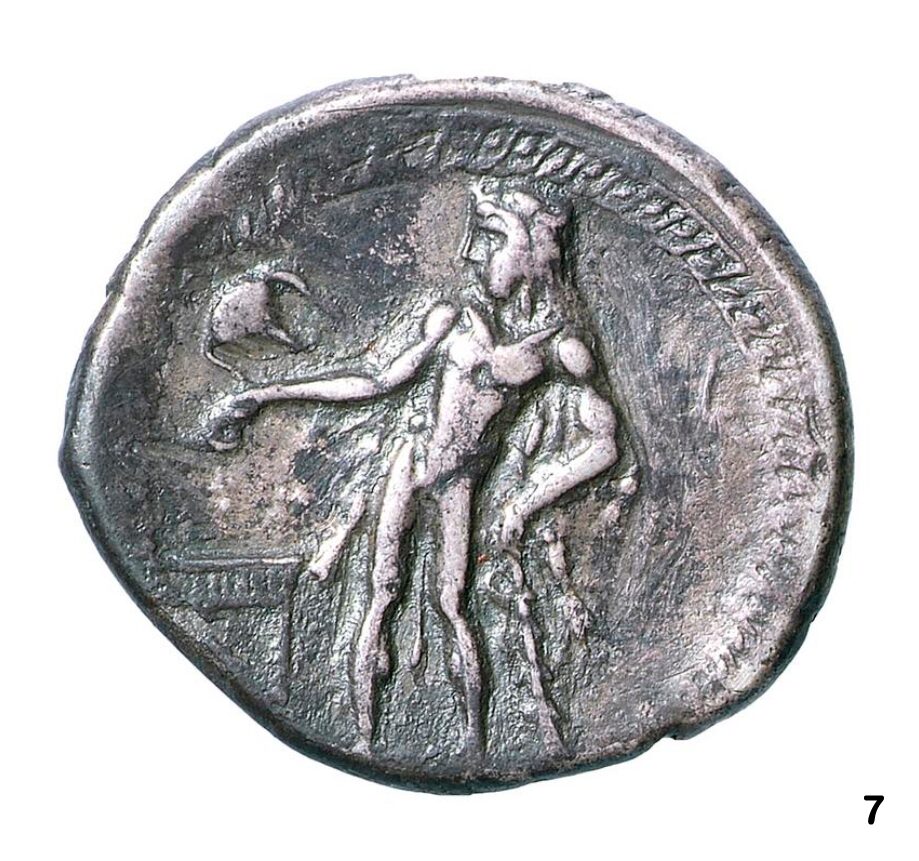


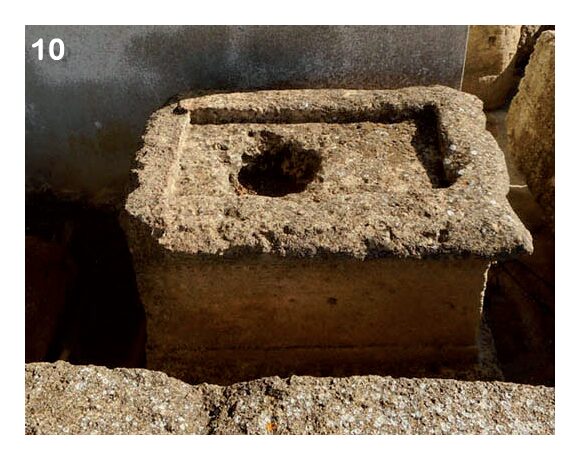
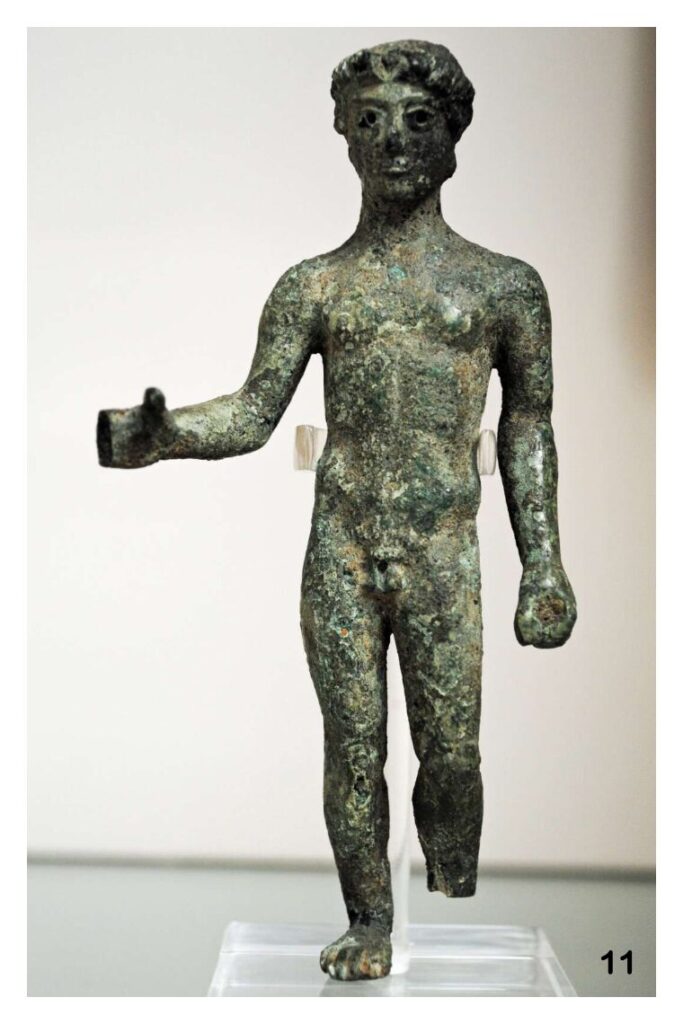


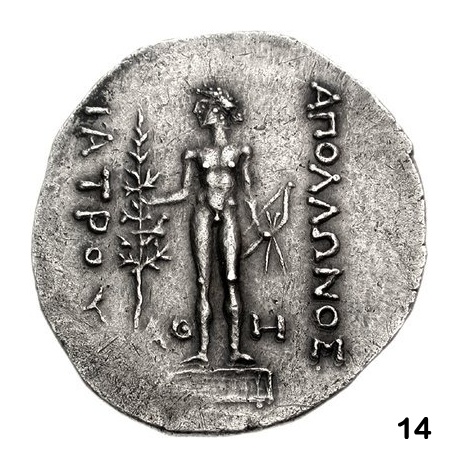
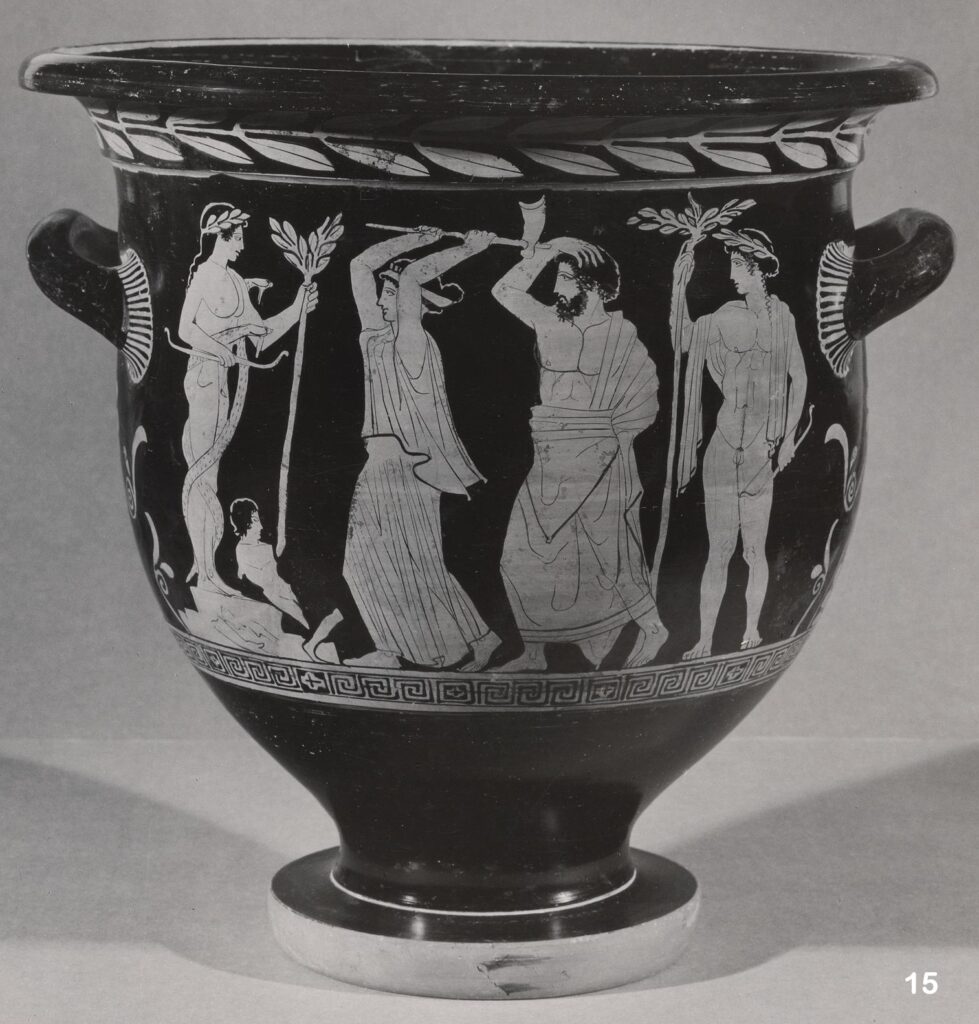
Date of Work: c. 450 BCE
Source of Date of Work: Rutter, Greek Coinages, 49-51; Stazio, Monetazione di Metaponto, 83-86
Key to images:
1. Reverse side of silver nomos coin (also called stater or didrachm), depicting Apollo holding a bow and a large, vertically standing laurel branch. Metapontion, 5th c. BCE. Die type Noe 315. Bibliothèque nationale de France, département Monnaies, Fonds général, no. 1144.
2. Same as 1, but with a stand supporting the laurel branch. Die type Noe 319. British Museum TC,p38.7.Met.
3. Same as 1. Die type Noe 316. British Museum 1866,1201.236.
4. Same as 1. Die type Noe 317. British Museum 1946,0101.325.
5. Same as 1. Die type Noe 314. British Museum EH,p101.5.Met.
6. Reverse side of a silver half-nomos (or half-stater or drachm), depicting Apollo holding a bow with his left hand and his right hand on his hip, ringed by two laurel branches. Metapontion, 5th c. BCE. Die type Noe 320. British Museum 1946,0101.326.
7. Reverse side of silver nomos coin, depicting Herakles wearing a lion-skin headdress, with club and bow in his left hand, and pouring a libation from a cup with his right hand onto a small altar. Die type Noe 312. British Museum 1870,1001.3
8. Same as 7. Recorded as die type Noe 312 but slightly differs. Bibliothèque nationale de France, département Monnaies, Luynes, no. 467.
9. Stone platform at Metapontion, proposed by David Hernández Castro to have been originally a small altar as pictured in the coins of images 7 and 8, and later repurposed as a platform supporting the large laurel branch held by an Apollo statue, as pictured in the coin of image 2. Hernández Castro, El Temenos, 115, fig. 3.
10. Top view of stone base pictured in image 9. Ibid., 114, fig. 2.
11. Bronze statuette, height 12.7 cm, proposed by Phyillis Williams Lehmann to be based on the Apollo Daphnephoros statue of Metapontion. British Museum 1867,0508.79; Lehmann, Statues on Coins, 33-35.
12. Torso of a broken marble statue, found near the temple of Apollo Lykios in Metapontion. Mertens-Horn, Scultura di Marmo, 74 fig. 81.
13. Reverse side of a silver tetradrachm depicting Kalamis’ colossal statue of Apollo Iatros in Apollonia Pontica (Sozopol, Bulgaria), 2nd c. BCE. Paunov, Apolloniate Tetradrachm, 13.
14. Same as 13, with different die and center inscription. Classical Numismatic Group (cngcoins.com), auction Triton XII, lot 128.
15. Crater decorated by the Pisticci painter, south Italy, 5th century BCE, depicting at left a statue of Apollo Daphnephoros similar to the one seen on the coins of Metapontion, in what is believed to represent a scene from the lost Sophokles tragedy Laokoon. Basel Antikenmuseum Lu 70; LIMC 15934; Schmidt, Laokoon-Mythos.